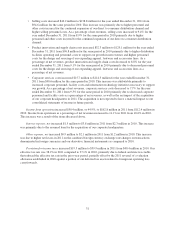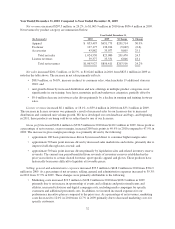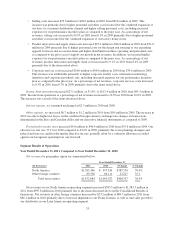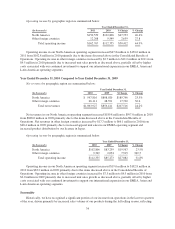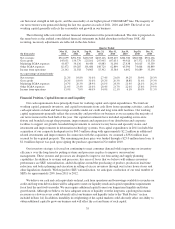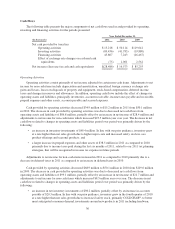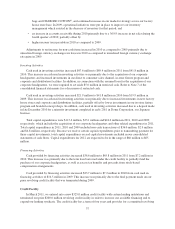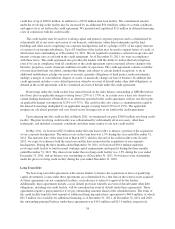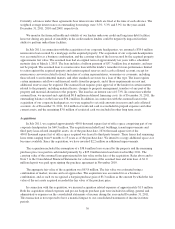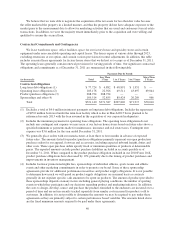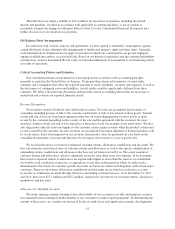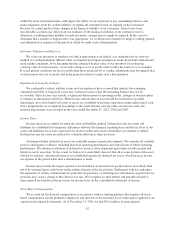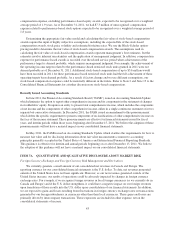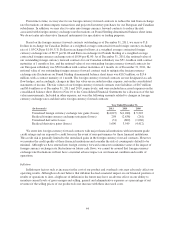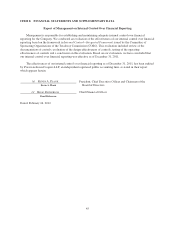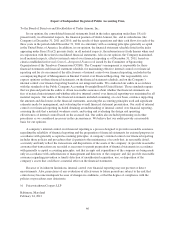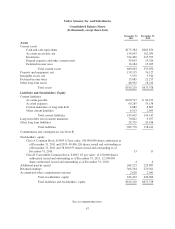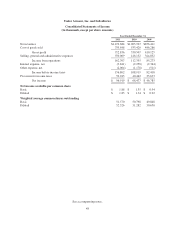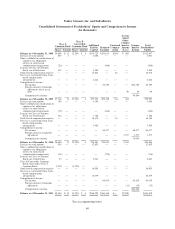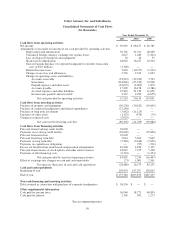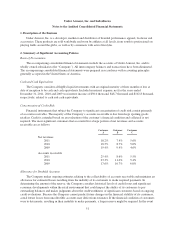Under Armour 2011 Annual Report Download - page 51
Download and view the complete annual report
Please find page 51 of the 2011 Under Armour annual report below. You can navigate through the pages in the report by either clicking on the pages listed below, or by using the keyword search tool below to find specific information within the annual report.The table above excludes a liability of $11.2 million for uncertain tax positions, including the related
interest and penalties, recorded in accordance with applicable accounting guidance, as we are unable to
reasonably estimate the timing of settlement. Refer to Note 11 to the Consolidated Financial Statements for a
further discussion of our uncertain tax positions.
Off-Balance Sheet Arrangements
In connection with various contracts and agreements, we have agreed to indemnify counterparties against
certain third party claims relating to the infringement of intellectual property rights and other items. Generally,
such indemnification obligations do not apply in situations in which our counterparties are grossly negligent,
engage in willful misconduct, or act in bad faith. Based on our historical experience and the estimated probability
of future loss, we have determined the fair value of such indemnifications is not material to our financial position
or results of operations.
Critical Accounting Policies and Estimates
Our consolidated financial statements have been prepared in accordance with accounting principles
generally accepted in the United States of America. To prepare these financial statements, we must make
estimates and assumptions that affect the reported amounts of assets, liabilities, revenues and expenses, as well as
the disclosures of contingent assets and liabilities. Actual results could be significantly different from these
estimates. We believe the following discussion addresses the critical accounting policies that are necessary to
understand and evaluate our reported financial results.
Revenue Recognition
Net revenues consist of both net sales and license revenues. Net sales are recognized upon transfer of
ownership, including passage of title to the customer and transfer of risk of loss related to those goods. Transfer
of title and risk of loss are based upon shipment under free on board shipping point for most goods or upon
receipt by the customer depending on the country of the sale and the agreement with the customer. In some
instances, transfer of title and risk of loss take place at the point of sale, for example at our retail stores. We may
also ship product directly from our supplier to the customer and recognize revenue when the product is delivered
to and accepted by the customer. License revenues are recognized based upon shipment of licensed products sold
by our licensees. Sales taxes imposed on our revenues from product sales are presented on a net basis on the
consolidated statements of income and therefore do not impact net revenues or costs of goods sold.
We record reductions to revenue for estimated customer returns, allowances, markdowns and discounts. We
base our estimates on historical rates of customer returns and allowances as well as the specific identification of
outstanding returns, markdowns and allowances that have not yet been received by us. The actual amount of
customer returns and allowances, which is inherently uncertain, may differ from our estimates. If we determine
that actual or expected returns or allowances are significantly higher or lower than the reserves we established,
we would record a reduction or increase, as appropriate, to net sales in the period in which we make such a
determination. Provisions for customer specific discounts are based on contractual obligations with certain major
customers. Reserves for returns, allowances, markdowns and discounts are recorded as an offset to accounts
receivable as settlements are made through offsets to outstanding customer invoices. As of December 31, 2011
and 2010, there were $27.1 million and $25.2 million, respectively, in reserves for customer returns, allowances,
markdowns and discounts.
Allowance for Doubtful Accounts
We make ongoing estimates relating to the collectability of our accounts receivable and maintain a reserve
for estimated losses resulting from the inability of our customers to make required payments. In determining the
amount of the reserve, we consider our historical levels of credit losses and significant economic developments
41


